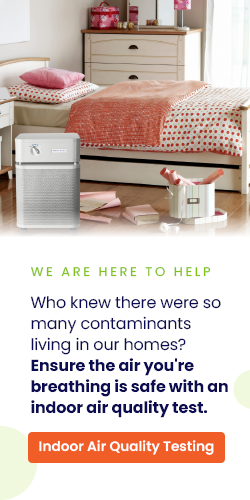Poor indoor air quality can trigger your eczema. When we think of what causes eczema, we immediately start looking at what we put in or on our bodies: Our dietary choices, the chemicals in makeup and moisturizers, etc. Seldom do we think about the air around us, even though it’s a well-known fact that indoor air is often highly polluted. This oversight is unfortunate, because improving indoor air quality can potentially do a lot to diminish eczema symptoms.
How Bad Indoor Air Quality Can Worsen Eczema
Unfiltered, poorly circulated air can cause (or exacerbate) eczema flareups in all of the following ways:
Volatile Organic Compound (VOC) Exposure
The term Volatile Organic Compounds (VOCs) refers to a number of different hazardous chemicals that are frequently found in indoor air, e.g., formaldehyde, benzene, propylene glycol, and acetone. According to a study conducted by Harvard University and Kalstad University, in addition to leading to a greatly increased risk of developing allergies and asthma, exposure to high concentrations of VOCs makes a person 2.5 times more likely to develop eczema.

10 Ways Your Baby’s Bedroom Air Quality Can be Improved
The Nature of Off Gassing
VOCs enter indoor air via a process called “off gassing.” The compounds in VOCs are usually found in household paints, solvents, wood preservatives, aerosol sprays, cleansers and disinfectants, bug repellents, air fresheners, automotive products, building materials, furnishings, office supplies, and even dry-cleaned clothing. As these things age, they gradually release vapors that contain VOCs into indoor air. In homes that are poorly ventilated, VOCs accumulate, causing eczema and other health problems.
The Link between VOCs and Eczema
While the link between VOCs and eczema is still being explored, scientists believe that these toxic compounds both damage the skin’s protective barrier and cause chronic inflammation. Chronic inflammation weakens the immune system, thereby contributing to skin conditions (like eczema and psoriasis) that have an autoimmune component.
End Your Indoor Winter Allergies
Poorly Ventilated Dusty Homes
Dust may seem like a harmless nuisance, but it can greatly contribute to the development of eczema symptoms. Not only is dust a direct skin irritant, it contains high concentrations of toxic properties that invade the blood stream. Furthermore, a large percentage of adults and children are allergic to dust mites, and there is a strong link between allergic reactions and the development of eczema. We find that homes with spray foam are dustier because of a lack of fresh air exchanges. We measure the lack of fresh air through the carbon dioxide levels.
Toxic Mold
Like dust mites, toxic mold spores frequently cause allergic reactions. Likewise, the toxic compounds in certain types of mold leads to chronic systemic inflammation and skin irritation that worsen eczema breakouts. often lead to a lack of indoor climate control.
Temperature and Humidity
Both temperature and humidity control are very important for eczema sufferers. Too much heat and humidity will irritate the skin by prompting excessive sweating and moisture retention, which leads to chronic itching and the potential for bacteria buildup. On the other hand, too much dry heat (as often occurs with the use of indoor heating systems during the winter) will cause the skin to flake, itch, and crack. For optimum comfort—and the reduction of eczema symptoms—people should keep their indoor environments temperate and moderately humid. However, this is difficult in poorly insulated or ventilated homes due to the potential for heat loss and moisture buildup.
How Can Indoor Air Quality Be Improved?
In order to remove mold, dust, and VOCs from the air of your home, you’ll need to do three things:
- Install at least one air cleaner on every floor of your home. Choose medical grade HEPA filters to effectively remove allergens and other fine particles from the air. We recommend the Austin Air and IQAir Brand purifiers. These are medical grade units.
- Condition your space for the optimal humidity levels (40-50%)
- Improve air flow through an energy recovery ventilation fan (ERV) or modern shower exhaust fan.
- Inspect the air quality in your home by a trained licensed indoor air quality expert. The experts at IndoorDoctor will locate hidden mold, measure VOCs in your home, and diagnose problems with the ventilation and insulation. We work together to devise effective solutions that will ensure everyone in your family is safe, comfortable, and eczema-free.







